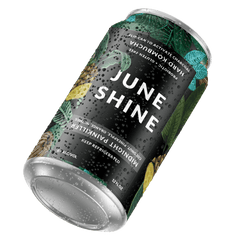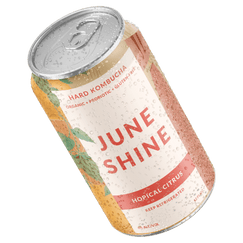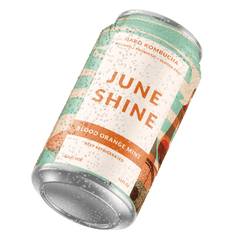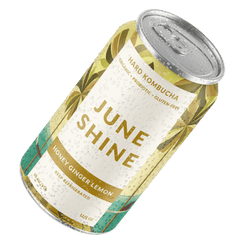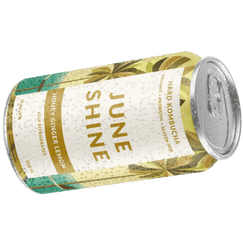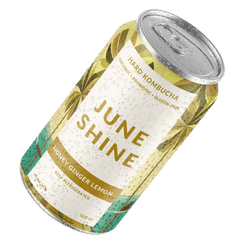What Is Kombucha? Get The Scoop

These days, everyone is hopping on the health food bandwagon—and rightfully so! We want to take better care of ourselves, each other, and the planet around us, and the foods and drinks we choose relate directly to that.
Stroll down a grocery store aisle, and you’ll see dozens of organic, vegan, and gluten-free options. Fewer people are eating meat as plant-based diets spike in popularity. Dairy has been steadily going out of style, as almond milk, coconut milk, and oat milk continue to steal the show. People are just becoming more health-conscious and looking to support their immune systems as much as possible, and they want products that can help them on that journey.
Did you hear someone knocking on the health food door? You did—it’s JuneShine Hard Kombucha, and we promise that we’re going to be best friends. This fermented beverage is made from a blend of yeast and bacteria, as well as tea leaves.
In terms of taste, it’s fizzy, dry, and just slightly sweet. It comes from the northeast regions of China, but also has a pretty cool history in Russia and Eastern Europe.
Check out all eight flavors of hard kombucha that we carry—whether you decide that you’re a Grapefruit Paloma gal or a Blood Orange Mint bro, there’s something you’ll love.
Pump Up the Probiotics and Bring on the Benefits
Most people drink kombucha for its abundance of probiotics, little guys that improve gut health and digestion by fighting off harmful microorganisms in the stomach.
Kombucha also contains tons of antioxidants, which can help slow down damage to cells by free radicals, unstable molecules that the body produces to protect itself from stress. You usually find these magical antioxidants in fruits and veggies like cranberries, peaches, spinach, and carrots. But we’re not your mom, and we’re not going to tell you to eat your veggies when kombucha is right there, tasting as awesomely antioxidant-rich as it does.
Kombucha is usually made from green or black tea, which also have a ton of benefits. Drinking green tea has been shown to raise your metabolism, lower belly fat, decrease cholesterol, and moderate blood sugar. Black tea can improve heart health, reduce blood pressure, lessen the risk of stroke and cancer, and lower blood sugar levels while also lowering cholesterol. Some say that drinking black tea also helps with focus. And while we’re not saying that your daily booch does all of that, we are saying that it’s made of some pretty awesome ingredients.
What Does Kombucha Taste Like?
The flavor of your kombucha will ultimately depend on how it was made and what kinds of fun add-ons made their way into the brew. You’ll generally notice a tart, herbal taste, which can be accompanied by sweet, light flavors that are sure to impress. You’ll also notice the bright, fizzy taste of this drink each time you take a sip.
If you’ve had fermented foods like yogurt, kimchi, and sauerkraut, you might think that you know what this fermented tea will taste like, but it really is in a class all its own.
With all the combos out there, there’s a flavor of kombucha that’s basically your soulmate in a can. With combos brewed with all kinds of ingredients, from fruit juice to chilis, there’s something for everyone. Try Hopical Citrus for an insanely delicious, hop-forward taste (yes! Like beer, but better), or hit the beach with Acai Berry. Get ready for flavors tap-dancing on your tongue, because JuneShine brings it all to the table.
How Kombucha Is Made
Kombucha has a lot going on in terms of taste, so it makes sense that brewing it takes a bit of work.
Booch is possible thanks to fermentation, our favorite chemical reaction. Oh, you don’t have a fave chemical reaction? That’s fine; you can try ours. In fact, we like it so much that our kombucha (and all hard kombucha, for that matter) goes through two separate fermentation processes. Booch so nice, we brewed it twice!
The drink is fermented with a blend of yeast and bacteria known as SCOBY (symbiotic colony of bacteria and yeast). Common strains of bacteria in kombucha include some crazy names like Acetobacter, Saccharomyces, and Brettanomyces, but we’re not going to test you on those. And no, those aren’t dinosaur names.
In the first fermentation, most producers use black tea leaves, since they interact best with the SCOBY. During the second fermentation, which is usually done at room temperature, you can bring in a blend of different teas and ingredients to really amp up the flavor.
The first fermentation usually takes about a week, as the SCOBY feeds on the sugar in the tea and brings in those probiotics.
The second fermentation process is where the bulk of kombucha’s flavoring comes from. During this process, producers add more teas to their batch, as well as additional sweeteners and additives.
Once fully fermented, the kombucha is stored in a refrigerated environment to slow down the carbonation and fermentation process. That’s when it comes to you!
An Extensive History
Though kombucha has really picked up speed in the past few years, it actually has a history that dates back to 220 BC. Yeah, this stuff is old.
The earliest documented use of kombucha was during the Qin Dynasty in China, when Japanese samurais would carry it in wineskins to drink during battle. The drink, originally known as "Sea Treasure," "Stomach Treasure," or "Sea Mushroom," was first used to increase energy. The next time you grab a can of JuneShine, try imagining that you’re a samurai special agent—it’ll give you a whole new perspective on how great this stuff is, although we don’t think we’ll be calling it Sea Mushroom any time soon.
The story goes that the name for kombucha comes from Dr. Kombu, a Korean physician who introduced the fermented drink to Japan as a remedy for Emperor Inkyo. Kombucha eventually traveled along the Silk Road, bringing good vibes all the way to Russia and then the rest of Europe.
The drink lived a good life in Europe until the start of World War II, when sugar and tea began to be rationed. In the 1960s, kombucha saw a brief resurgence, largely due to a popular study conducted in Sweden comparing the health benefits of kombucha to yogurt. If you associate kombucha with a hippy-dippy vibe, this is probably why.
In the 1990s, the drink spiked in popularity again, but since then, kombucha has kept a relatively low profile. Today, we’re rediscovering and reimagining this classic drink, and we’re honestly not sure how we lived without it.
Where Does the Booze Come From?
Let’s get this out of the way: standard kombucha is not an alcoholic beverage. The amount of alcohol in run-of-the-mill kombucha is not enough to even get you buzzed.
That small amount of alcohol is a necessary part of kombucha. During fermentation, carbon dioxide and ethanol (aka alcohol) are naturally produced, and some of it just sticks around.
Your average can of booch will contain less than 1% ABV. Compared to most beers, which hang around 3-4% ABV, this is practically nothing. Of course, that all changes when you choose a kombucha that purposely contains more alcohol...
JuneShine Hard Kombucha: The New Beer?
Today, drinkers are loving lower-calorie drinks like spiked seltzer and, you guessed it, hard kombucha. They’re an easy way to bring the good vibes and feel just a little better about what you’re drinking.
Beer is popular for a reason. It has a low ABV, so it makes for easy drinking, most of it is cheap, and it tastes great. That said, they call it a beer belly for a reason.
Most hard kombuchas have an alcohol content between 3% and 7%—which is often even more than beer! You’ll also find JuneShine hard kombucha contains just a few grams of sugar and less than ten carbs per serving—you’re welcome.
Conclusion
Once upon a time, kombucha was enjoyed in ancient China and was fit for emperors. Nowadays, you’re lucky enough that you can walk into any supermarket and find a refreshing bottle of the good stuff just waiting for you.
Tart, fizzy, and sweet; that’s what makes a great kombucha, and you’ll know it when you taste it.
This summer, grab an ice-cold Junie. This drink is perfect for any scenario, whether you’re on the beach, by the poolside, or just hanging with friends on a classic summer night.
---
Sources:
Antioxidants: Health benefits and nutritional information | Medical News Today
Kombucha 101: Demystifying The Past, Present And Future | Forbes
